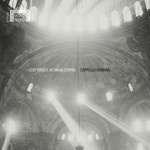|
Back
05/22/2020
“Lost Voices of Hagia Sophia”
Medieval Byzantine Chants: Vespers Antiphon – Psalm 140 Kekragarion – Matins Antiphon 7 Introduction – Antiphon 7 Verses – Antiphon 7-Kanon Ode 4 – Troparian of The Cross – Asmatikon Troparian – Kontakion of The Cross – Sticheron by Leo VI – We Venerate Your Cross – Prokeimenon – Asmatikon Cherubic Hymn – Communion Verse
Cappella Romana, Alexander Lingas (music director and founder)
Recording: CCRMA, Stanford University, California; Perfect Record, St. Paul, Minnesota; Skywalker Sound, a Lucasfilm LTD. Company, Marin County, California (2011, 2013 and 2016) – 76’50 [80’ for Blu-ray including bonus documentary film]
1 CD and 1 Pure Audio Blu-ray Cappella Romana CR420-CDBR – Booklet in English

   
Proudly situated above the Bosporus lies colossal Hagia Sophia. Built in 532-37 A.D. under Emperor Justinian, the edifice was a symbol of early Medieval Byzantine strength and a powerful venue for early Christianity. Within the architecture was its ability to house some of the most amazing acoustics in the world. This is where the journey of Cappella Romana, under the leadership of Alexander Lingas, begins. Efforts by the group’s founder in capturing the music, once lovingly reverberated inside the weightless dome, was painstakingly arduous.
After the Fall of Constantinople in 1453, the Hagia Sophia was turned into a mosque. Forwarding into the 20th century, back in 1935, Kemal Atatürk disallowed the human voice to permeate its walls, instead he secularized the structure and turned it into a museum. Stanford’s art professor Bissera Pentcheva and acoustical engineer Jonathan Abel began a massive undertaking, beginning in 2011, to measure resonances and endless calculations of trigonometric sine and cosine curves to superimpose voice via independent venues that closely matched those acoustical qualities floating within the Hagia Sophia.
Collected not only on one CD, Cappella Romana also includes a Pure Audio Blu-ray disc which houses a 24-minute documentary film, “The Voice of Hagia Sophia”. This is an excellent place to start experiencing the wonderment of chants. Being exposed to undergraduate courses in art history likely would reveal the well-recogonized H.W. Janson’s Second Edition of History of Art. By looking through the Hagia Sophia chapter (beginning on page 206) while listening to this ravishing music is an enrichment unlike any other.
Hagia Sophia’s echoing can sustain up to 12 seconds of frequency. This becomes an important element in imparting a luscious liquidity. The forever changing reverberant qualities are highly unique since this massive space allows particulate matter to float and be “cycled” through the air: it aids and impedes the chants. It’s easily mesmerizing. Flowing like liquid gold in a randomized, though organized fashion, the chanting literally “washes” over the listener: it shimmers, it stuns, it absorbs the body. Look at it like oceanic swells…no two waves are ever alike. This is the irrefutable case about the Hagia Sophia. Despite an absolute ever being exacted, Cappella Romana and staff have been sophisticated and mathematical in their methodology to re-enact as best as possible. The 40 page booklet also guides the listener though every nook and cranny. The presentation is FIRST CLASS!
This is one of the most unusual and rare perspectives ever to surface in the Early Christian Byzantine era. Voices may have been lost under the dome of the Hagia Sophia, but Alexander Lingas and the 14-member Cappella Romana have made a historic reawakening.
Christie Grimstad
|